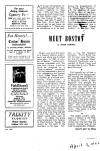
Home Page Meet Boston Menu Index
|
MEET BOSTON Friday, April 3, 1942 in What's New In Town W. J. Sidis |
An actual conversation reported between two Bostonians, meeting in New York: “Why are New York subways so much more crowded than Boston ones?” “You see, they charge 10 cents in Boston, and only 5 cents in New York. So in New York they’ve got to get twice as many people in.” There may be something to it, at that.
*
Boston was once the scene of a famous Utopian experiment, just about one hundred years ago. In 1835, a number of Boston “intellectuals” became impressed with the idea that current injustices could be remedied by a “back-to-nature” movement and they proceeded to pool all their possessions and bought a farm, called “Brook Farm,” in Newton, on a hillside overlooking “Eliot’s Pulpit,” a large chair-shaped piece of Roxbury puddingstone, where (according to tradition) Apostle John Eliot sat when preaching to the Indians. At Brook Farm the experimenters lived together in what they imagined to be a communal life, and, though all “city folks,” they attempted to make a go of farming, which none of them understood. In the depression year of 1837, many new recruits came to Brook Farm, contributing what little they had left to join the farm that they hoped would take care of them. In 1838, the place was transferred from Newton to West Roxbury, though the reason for this shift in the boundary is not clear. Following the incorporation of the “Brook Farm Phalanx,” with the adoption of some European ideas of regimentation, the popularity of the experiment dwindled fast, and it never recovered after a fire in 1841. In 1847 the experiment was abandoned, and the place was converted into a poor-farm. [It was renamed] as “Camp Andrew” in the Civil War, and is now Mt. Benedict Cemetery. Eliot’s Pulpit can still be seen, over the Newton line on Lagrange Street. Nathaniel Hawthorne was a member of Brook Farm, and has described it in his “Blithedale Romance.”
*
Old legends tell of how a Sagamore of the Saugus people married the daughter of the great Bashaba of the land of Penacook (which is New England) and brought his bride back to his Saugus home (at what they now call the Buchanan Bridge section of Lynn). The young couple then set up their own home on a nearby promontory jutting far out into the sea, where they went with a group of friends to serve as a guard against hostile raids from the water. This new settlement they named for the bride, Nahanta. The place is still called Nahant.
*
The oldest current newspaper in Boston is the Post, (started in 1831). It was named from the fact that the original founder was at the time the postmaster of Boston.